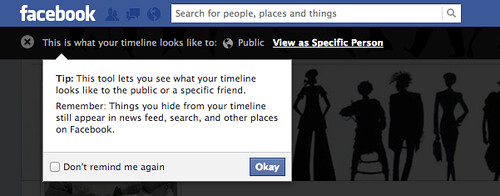Options for Self-Viewing on Facebook
- Posted on February 27, 2013 at 12:19 pm by Kevin Hamilton.

fb screenshot
In-progress research notes, shared as evidence of process.
Facebook allows you to see what your timeline looks like to strangers, or to individual friends, including friends from whom you hide certain posts. This affords the user something like the view offered from a “true mirror” or a live video feed of oneself. But even this view is limited, in that these views don’t include items that you excluded from your timeline.
Facebook also allows you to download all your content, which you can scroll through over a great deal of time. But this information includes nothing about your privacy settings for particular posts. So it’s solely a content dump, with almost no context. In this dataset you can see time, date, numbers of likes, and comments on each status update or picture. You can see whether your images (not your statuses) were shared only with “friends.” But if you don’t limit the image to only friends, the image is not marked as shared with public, we only infer that information. No apparent data about more finely-grained sharing distinctions.

We should look some at Wolfram’s FB visualizer for another example of how users can view their own data. Here again, I don’t see anything about privacy networks right away.
What we want to make is a way for users to visualize “how they look to Facebook” as well as “how they look to others.”
Facebook allows you to see “what others will be able to see about me” as well as “what content I have uploaded to Facebook.” For the latter, you can also see your uploaded content in terms of date and time.
But FB doesn’t make it possible for you to see, outside the level of individual posts, the explicit or infer-able social metadata associated with your uploaded content – namely, whom your intended audience is for any given content contribution. You also can’t easily see (outside of looking closely, at individual posts) what the shape of distribution for your content has been – who passed it along to whom, and in front of whom.

To use an analogy –
Let’s say you’re a HAM radio operator who also makes very careful notes. You would likely have a log of all your nightly communications – which operators you made contact with, and what you talked about, and who else identified themselves as present on the channel. Such a log would offer one a shape of your broadcast life over time, and help you see “where you’ve been” for future reference about where you want to go next, who you might like to talk to in the future, and about what.
If you didn’t keep good logs, however – or if it wasn’t common practice for HAM radio operators to identify themselves on air – you might only have a record of which nights you broadcast, and about what you might have spoken. Your record would be more like that of an FM or AM broadcaster, and your 2-way medium would only have a 1-way history.
That’s a bit what FB is like right now. Sure, you can see at a glance – even on a single screen, in the case of the downloadable archives – who has responded to your posts (though not who “liked” them.” But you can’t see who potentially heard you, read you, saw you, and perhaps showed others.

What’s needed is something like a sonar for FB, a way to ping the dark depths and discern the shape of your audience for particular speech acts.

The party-line phone user picks up the phone. “Who’s out there?” she asks. People answer. The user then addresses them, speaks for and to them (if also cautiously aware about who else might be lurking, listening without speaking up.)
How does that happen on FB?
And why should it matter?
Well, it matters for at least two reasons.
- Public address is shaped by the speaker’s knowledge of the public (unless the speaker is a totally un-empathetic ranter/psychopath)
- Where FB potentially knows about the shape of your audience and channels, they have the chance to market those channels.
As an analogy for the latter, imagine that a radio advertiser wants to get their product out to an audience in rural Australia where they have no penetration. The advertiser would have to identify the correct radio channels for that audience, and then purchase time on them.
Our individual social media spaces are like that – they offer potential channels for broadcast. We need to know that shape of our channels not only so that we can use them, but so we can decide on their worth in the emerging “privacy market.”
If a product wants to use you as a hawker, what should it be worth to you?
Possible Methods:
- Visualization based on your downloaded FB archive. (Doesn’t seem ideal, for reasons stated above.)
- Scrapes of individual users pages (laborious, difficult to scale)
- Model the whole thing in a separate piece of software (questionably practical.)
- An actual app, update or ad, sent out like sonar to retrieve data. (Anyone know the child’s game Marco Polo?)

dog
The latter would seem realize-able in some simple ways. The trick is that, unlike Bat sounds, underwater sonar or the marco polo game, response from a “ping” in social media is content-dependent.
So something like sonar that bounces back based on particular filters. So, for example, the sonar bounces back only if:
- someone hears it who doesn’t know you
- the person is on your “aquaintance” list
- the person has been active on Fb within x minutes of your posting, suggesting likely contact
- the person shares an interest with you
- the person has or hasn’t blocked you from their timeline